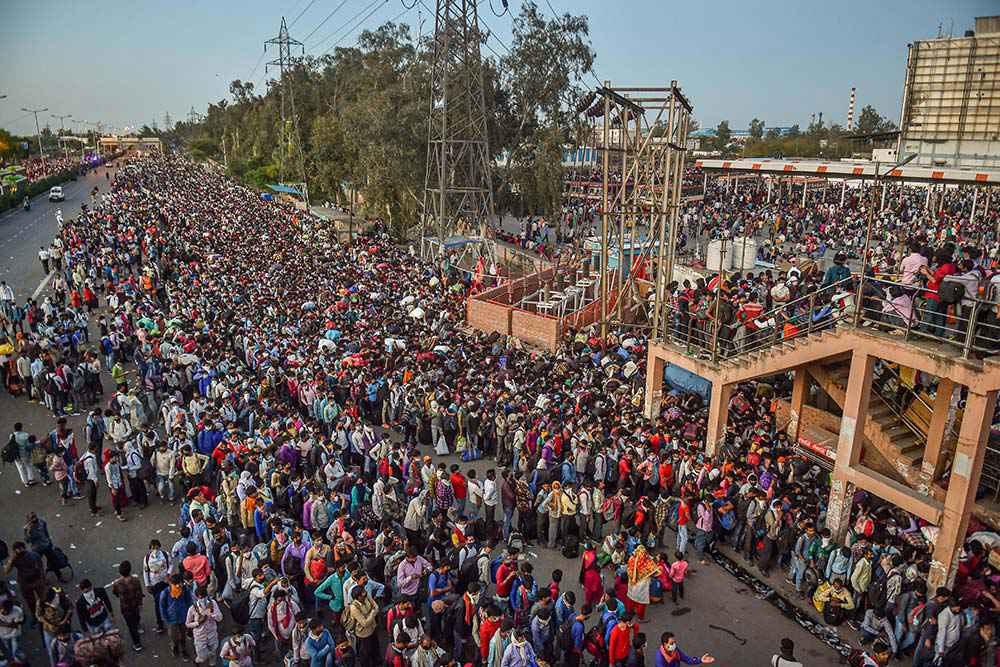
Those mercilessly pink-slipped are often too scared to even tell their families. “I don’t have the courage,” reveals Rohit Verma (name changed), who worked in the marketing division of Makino India, an auto-ancillary firm, and whose family includes his wife (homemaker), old parents and two children. Those who are at home are unsure if they will ever go back to their offices. “My owner gave Rs 7,000 in March, when the lockdown was announced. He assured us of future salaries, but I am not sure. I am not even sure about my job,” says Deepak Kumar, who operates a cloth-weaving machine at a garment firm.
Fortunately, there is also an optimistic scenario—indeed, that will most likely intersect with the more depressing tendencies to produce a complex reality. The usual picture of a shell-shocked economy with zero demand may be too simplistic. Yes, the pain of unemployment will be felt acutely over the next three to six months, but there can also be a quick rebound. In fact, the creation of fresh jobs and a return of old ones may happen sooner than we expect due to two reasons. The first is psychological: consumers, liberated after being cooped up at home for over five weeks, may go berserk once the lockdown is lifted. They may wish to buy more, spend more—certainly, travel more. It may be irrational, but very human to go overboard. Of course, this release of pent-up demand will be restricted to those who retain their jobs.
Brand expert Harish Bijoor offers a more concrete reason to feel optimistic. He says that although Goldman Sachs and World Bank have predicted the world economy could witness a negative growth of up to 3 per cent, and India to grow at a mere 1.5-1.6 per cent, the latter may not be true. India is less dependent on exports compared to China and Japan, he points out, and has a huge domestic demand—so growth may “remain static” around 4-5 per cent. In addition, economic crises in countries like India tend to boost labour productivity.
Ultimately, it will be a toss-up between three scenarios—a V-shaped recovery, a U-shaped one or an L-shaped one. US President Donald Trump has categorically talked about the first—saying that the US and other economies will immediately rebound once the lockdowns are lifted, and, hence, there will be minimal unemployment and higher-than-estimated growths. Most experts are nervy and apprehensive: they believe the U-shaped scenario to be more likely, and expect the lower plateau to last for anything from six months to a few years.
Only if the IMF’s dire prediction turns out true—which is that the COVID-19 crisis will be the worst after the Great Depression of the 1930s—will we be staring at the dismal L-shape spreading across the globe. That is, once growth plummets across countries, it will hug that low level for several years. In the case of the Great Depression, this trend lasted for over a decade. In such a situation, expect job losses in India to be nearer to 200 million, besides a long-lasting, severe impact on everything and everyone related to farming.
However, there are too many ifs and buts here. No one has seen such a scenario before—and we don’t know if the recovery will be V-shaped, U-shaped or L-shaped (those are just shapes in a nervous Lego toy game we are playing right now). We don’t even know if we can compare across a century. The Great Depression was caused by huge and deep-rooted systemic problems that were accentuated by entrepreneurs, central bankers, policymakers and investors. This crisis is the result of an external shock; the state of most economies was within the range of normal, if not exactly in the pink of health. Hence, how the economies, consumers and entrepreneurs react is still in the realm of speculation and educated guesswork.
发表回复